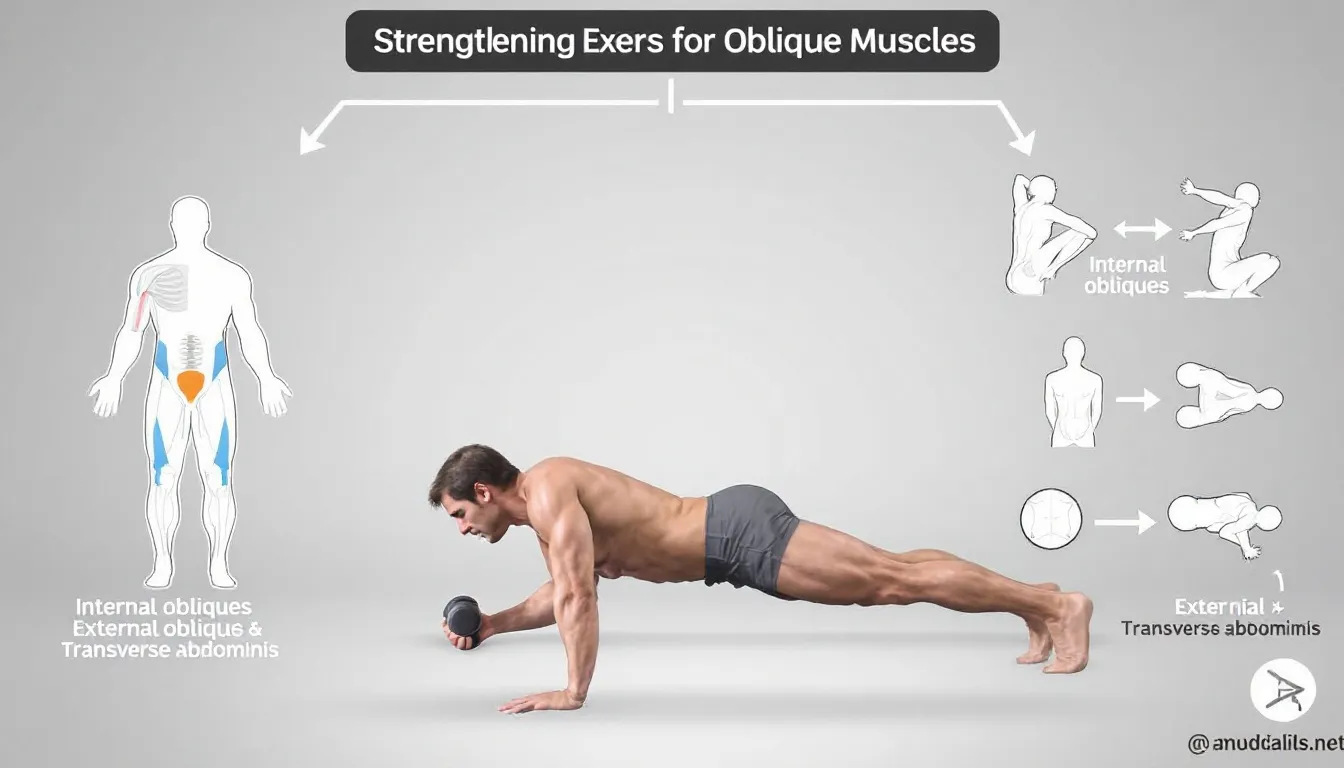An oblique muscle injury happens when the muscles on the sides of your abdomen are strained or torn. This type of injury can cause pain and limit your movement. In this article, learn the symptoms, proper diagnosis, and effective treatments to help you recover quickly.
Key Takeaways
-
Oblique muscle injuries often occur due to sudden movements or overuse, requiring careful management for proper healing.
-
Recognizing symptoms such as muscle soreness and sharp pain can lead to timely diagnosis and effective treatment, including rest and physical therapy.
-
Preventive measures, such as core strengthening exercises and proper lifting techniques, are crucial to reduce the risk of oblique muscle injuries.
Understanding Oblique Muscle Injuries

The oblique muscles are a pair of muscle groups located on the sides of the abdomen, stretching from the lower ribs to the pelvis. They are divided into external oblique muscles and internal oblique muscles. These muscles are essential for supporting the torso, facilitating movement, maintaining balance, rotating the trunk, and bending the trunk. Whether you’re twisting to grab something from the back seat of your car or powering through a tennis match, both the muscle and your abdominal muscles and oblique muscles are hard at work.
Oblique muscle injuries commonly happen because of sudden movements or overuse. They can also result from improper technique and forceful twisting or hyperextension. These injuries can range from mild muscle strain to severe tears, depending on how much the muscle fibers are stretched or torn. For example, a sudden twist while playing sports or lifting a heavy object improperly can easily lead to an oblique strain.
When these muscles are pushed beyond their limits, it can lead to significant setbacks. Not only can an oblique injury prevent you from participating in activities you love, but it can also impact your overall fitness and daily life. An oblique strain, specifically, refers to the stretching or tearing of the oblique muscles and requires careful management to ensure proper healing.
Symptoms of Oblique Muscle Injuries

Recognizing the symptoms of an oblique muscle injury is crucial for timely treatment. Common symptoms include:
-
muscle soreness
-
spasms
-
stiffness
-
bruises
-
swelling
If you’ve injured your external oblique muscle, you might experience sharp, localized discomfort beside the abdomen that worsens with bending or twisting. This kind of sharp pain can be quite intense and may even limit your movement.
On the other hand, internal oblique muscle injuries can manifest differently. The discomfort may increase with actions like deep breathing, coughing, or sneezing. Pain from internal oblique injuries often radiates across the abdomen and can affect the lower back, leading to one-sided low back pain. Identifying these symptoms early can help in seeking appropriate medical attention and starting the recovery process as soon as possible.
Diagnosing an Oblique Muscle Injury
Proper diagnosis is the first step towards recovery from an oblique muscle injury. During a medical examination, a healthcare professional might ask you to perform specific movements, such as a sit-up, to evaluate the pain and pinpoint the injured area. This helps in understanding the extent of the injury and determining the most effective treatment plan.
If pain persists or worsens, it is essential to consult a healthcare professional. They can perform a thorough examination and recommend appropriate treatments to alleviate the pain and promote healing. Ignoring persistent pain can lead to further complications, so timely diagnosis and intervention are crucial.
Treatment Options for Oblique Muscle Injuries

Treating oblique muscle injuries often requires a combination of approaches, depending on the severity of the injury. Conservative treatment is usually sufficient for most oblique muscle strains, enabling athletes and active individuals to return to their activities. This includes rest, physical therapy, and in some cases, advanced treatments to promote healing and reduce inflammation.
Let’s delve deeper into these treatment options.
Rest and Initial Care
Rest is fundamental in the recovery process from an oblique muscle injury. Engaging in rest and avoiding activities that may aggravate the injury is essential for effective recovery.
The PRICE principle is often applied for immediate treatment. It includes:
-
Protection
-
Rest
-
Ice
-
Compression
-
Elevation
Using cold compresses and ice can help manage pain and reduce inflammation.
Additionally, anti-inflammatory medications like Aleve can significantly aid the recovery process by reducing pain and swelling. Proper rest and initial care promote healing and reduce the risk of further injury, paving the way for a full recovery.
Physical Therapy
Physical therapy plays a pivotal role in the recovery from oblique muscle injuries. A physical therapist will focus on strengthening and stabilizing the core, along with gentle stretching exercises to enhance flexibility and support the injured area. Specific strengthening exercises targeting the affected oblique muscles are introduced gradually to avoid sudden movements that could exacerbate the injury.
Patients typically work with a physical therapist twice a week for about four weeks for less severe oblique strains. Therapeutic modalities such as myofascial release may also be incorporated into the rehabilitation plan to alleviate muscle tightness and promote healing. This structured approach ensures a steady path to recovery.
Advanced Treatments
For more severe strains, advanced treatments may be necessary to facilitate recovery. Hydrodissection, a minimally invasive treatment method, can relieve muscle tightness and improve overall recovery rates. This technique involves injecting a solution to separate muscle and fascia layers, reducing inflammation and promoting healing.
Therapeutic massage and myofascial cupping massage are other advanced treatments that can assist in the recovery from an oblique injury. Incorporating these advanced treatments can significantly enhance the recovery process, ensuring that the injury is treated comprehensively and efficiently.
Recovery Timeline and Tips

The recovery timeline for oblique muscle injuries can vary depending on the severity of the strain. Mild oblique strains usually heal within two to four weeks, while severe strains may require up to eight weeks for complete recovery. On average, recovery can take a few weeks to six weeks.
To ensure a smooth recovery, it is crucial to avoid rushing the process to prevent further injury. Listening to your body and taking breaks when feeling discomfort are essential steps in preventing re-injury. Incorporating frequent rest, gentle stretching, and gradually building strength in the oblique muscles can aid in a full recovery.
Severe oblique muscle strains may take longer, but with proper care and patience, you can fully recover.
Preventing Oblique Muscle Injuries

Preventing oblique muscle injuries starts with proper warm-up routines and dynamic stretches. Exercises like trunk twists and side bends are effective in preparing the oblique muscles for workouts, significantly decreasing the risk of injury. These warm-up routines ensure that the muscles are ready for the physical demands ahead.
Strengthening the core muscles is crucial for maintaining proper posture and alignment, which helps support the spine and pelvis. A strong core can alleviate back pain and prevent conditions like osteochondrosis. Conversely, weak core muscles can lead to posture issues, such as back curvature and shoulder stooping.
Incorporating core-strengthening exercises and proper lifting techniques into your routine can help prevent oblique strains. Using proper form when lifting heavy objects, such as bending at the knees and hips while keeping the back straight, minimizes the risk of an oblique strain. Focusing on core strength and proper techniques significantly reduces the likelihood of oblique muscle injuries.
Real-World Examples of Oblique Muscle Injury Recovery
Real-world examples of recovery from oblique muscle injuries can offer inspiration and practical insights. For instance, Jane, a tennis player, suffered an oblique strain while attempting a powerful serve. She needed several weeks of rest before she could return to her activity. Her rehabilitation focused on strengthening her core and gradually increasing her activity levels.
Another example is an individual who managed to play 90 holes of golf over 2.5 days while recovering from a mild strain and an oblique strain. By taking pain relief and employing regular stretching, they were able to manage their condition and continue participating in their favorite activity.
These real-world stories highlight the importance of proper recovery strategies and the perseverance required to overcome oblique muscle injuries.
The Role of Core Strength in Long-Term Health
Core strength plays a vital role in overall health and injury prevention. Physical therapy typically includes exercises that focus on strengthening and stabilizing the core muscles. Maintaining good posture during workouts and daily activities prevents unnecessary strain on the obliques.
Incorporating exercises like Russian twists, side planks, and bicycle crunches helps in building strength in the oblique muscles. A strong core is essential for overall health and aids in the prevention of injuries, ensuring long-term performance and well-being.
By keeping the core strong, you can support your body in various physical activities and reduce the risk of injuries.
Summary
In summary, oblique muscle injuries can significantly impact your daily life and athletic performance. Understanding the anatomy and function of the oblique muscles, recognizing the symptoms of an injury, and seeking proper diagnosis are crucial steps in managing these injuries. Treatment options, ranging from rest and physical therapy to advanced treatments, play a vital role in recovery.
Preventing oblique muscle injuries through dynamic stretches, core-strengthening exercises, and proper techniques is essential for maintaining long-term health. Real-world examples of recovery and the importance of core strength further emphasize the need for a comprehensive approach to managing and preventing oblique muscle injuries. By following these guidelines, you can ensure a smooth recovery and maintain a strong, healthy core.
Frequently Asked Questions
What are the common symptoms of an oblique muscle injury?
Common symptoms of an oblique muscle injury include muscle soreness, spasms, stiffness, bruising, swelling, and sharp, localized pain near the abdomen that intensifies with bending or twisting movements.
How is an oblique muscle injury diagnosed?
An oblique muscle injury is diagnosed through a physical examination where a healthcare professional may ask you to perform specific movements, like a sit-up, to assess the pain and identify the injury. If pain persists, further evaluation and treatment options are recommended.
What are the initial treatment options for an oblique muscle injury?
The initial treatment options for an oblique muscle injury include rest and the PRICE principle—protection, rest, ice, compression, and elevation—along with cold compresses and anti-inflammatory medications, such as Aleve. These measures help manage pain and reduce swelling effectively.
How long does it take to recover from an oblique muscle injury?
Recovery from an oblique muscle injury typically takes two to four weeks for mild strains and up to eight weeks for severe strains. It's important to follow appropriate rehabilitation protocols to support your recovery.
How can I prevent oblique muscle injuries?
To prevent oblique muscle injuries, focus on thorough warm-up routines, incorporate dynamic stretches such as trunk twists and side bends, strengthen your core, and use proper lifting techniques. Taking these precautions can significantly reduce your risk of injury.











































Leave a comment
This site is protected by hCaptcha and the hCaptcha Privacy Policy and Terms of Service apply.